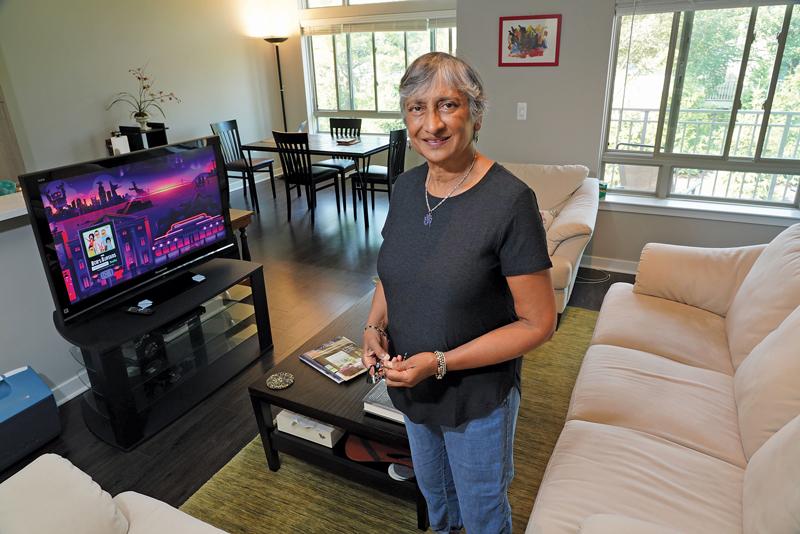“For more than twenty years, we lived in a house off Newport Creek that was more than 3,000 square feet,” Lakshmi Narayanan says. But she and her husband, M.P., are empty nesters, and their daughter’s family has a nest of their own in Philadelphia.
“In 2019, a house just down the street from our daughter’s went on the market, and we decided to sell,” Narayanan says. “It is a four-minute walk from hers.”
They bought the house in Pennsylvania and spend as much time as they can there with their daughter and grandkids. But they haven’t cut their ties to Ann Arbor: M.P., a U-M professor of business administration and finance, is still working. “So we decided to rent,” Narayanan says.
She had three stipulations for the rental: a laundry inside the unit, an attached garage, and quick access to downtown Ann Arbor–“We had been spoiled, living in suburbia.” The couple toured many older apartments downtown, but nothing seemed right. “And then we drove past Uptown,” Narayanan says.
Uptown Ann Arbor, that is. It’s not in Ann Arbor–it’s at Ann Arbor-Saline Rd. and Oak Valley Dr., in Pittsfield Township–and it’s not really “up” from anywhere. But the commercial/residential complex completes Pittsfield’s reconfiguration of the area, which has turned a small cluster of suburban-style shopping centers into something that feels a lot like a mini-downtown.
Instead of grassy berms and vast parking lots, Ann Arbor-Saline Rd. is now framed by businesses set close to the road in what was once vacant land and the far reach of Meijer’s parking lot. Only a sidewalk and thin strip of grass separate this new generation of businesses from the thoroughfare.
And Uptown Ann Arbor’s design was just what the couple wanted. While other area high-volume residential properties tend to favor Midwestern or traditional East Coast styles, Beztak Properties describes its look as “sleek, elegantly stylish, and undeniably international.”
“It was new, more contemporary, bright, and airy,” Narayanan says. And “it met all our requirements.”
Uptown’s rents are not for the faint of heart: according to property manager Tyler Smith, in mid-2021, its 197 units were priced between $1,600 per month for a one-bedroom to $5,000 per month for its most luxurious lofts. Townhouses ran from $2,500 to $2,700. Yet Smith said the complex was 94 percent occupied, with only the largest lofts still on the market.
Smith says Uptown actually benefited from the pandemic, which caused a flood of rental applications. “People spent a lot of time in their homes, and they started valuing where they live in a different way,” he says. “They decided to look for new and finer amenities.” And with the housing market “going crazy, people decided to take advantage of the surge and sell their houses, rent for a while, and decide where to go from there.”
“We were probably among the first to look at Uptown, in January 2020, as soon as we had a serious offer on our house,” Narayanan says. By the time their sale closed in February, their first and second choices had already been rented. They took a similar unit, with a garage, one study/bedroom and one bath on the first floor, and two bedrooms, two bathrooms, a kitchen, and living space on the second floor.
Uptown’s brand-new construction is what initially sold the couple on the development, but its proximity to shopping is a plus–“if need be, we can even walk to shops if we choose to do so,” Narayanan says. And “with the highway entrance so close, I can get to so many places quickly, both in town and in Ypsilanti, where I have friends.”
She also discovered another benefit: “I have been surprisingly pleased with our balcony, which faces west. I see a lot of sky–which I couldn’t see from our house.
“I’ve watched huge flocks of birds flying back and forth. I’ve come to enjoy watching the nature here, something I hadn’t anticipated.”





